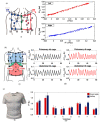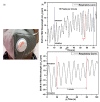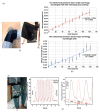Wearable Optical Fiber Sensors in Medical Monitoring Applications: A Review
- PMID: 37571457
- PMCID: PMC10422468
- DOI: 10.3390/s23156671
Wearable Optical Fiber Sensors in Medical Monitoring Applications: A Review
Abstract
Wearable optical fiber sensors have great potential for development in medical monitoring. With the increasing demand for compactness, comfort, accuracy, and other features in new medical monitoring devices, the development of wearable optical fiber sensors is increasingly meeting these requirements. This paper reviews the latest evolution of wearable optical fiber sensors in the medical field. Three types of wearable optical fiber sensors are analyzed: wearable optical fiber sensors based on Fiber Bragg grating, wearable optical fiber sensors based on light intensity changes, and wearable optical fiber sensors based on Fabry-Perot interferometry. The innovation of wearable optical fiber sensors in respiration and joint monitoring is introduced in detail, and the main principles of three kinds of wearable optical fiber sensors are summarized. In addition, we discuss their advantages, limitations, directions to improve accuracy and the challenges they face. We also look forward to future development prospects, such as the combination of wireless networks which will change how medical services are provided. Wearable optical fiber sensors offer a viable technology for prospective continuous medical surveillance and will change future medical benefits.
Keywords: fiber Bragg grating; healthcare; optical fiber sensors; wearable sensors.
Conflict of interest statement
The authors declare no conflict of interest.
Figures























References
-
- Umapathi R., Park B., Sonwal S., Rani G.M., Cho Y., Huh Y.S. Advances in optical-sensing strategies for the on-site detection of pesticides in agricultural foods. Trends Food Sci. Technol. 2022;119:69–89. doi: 10.1016/j.tifs.2021.11.018. - DOI
-
- Sareh S., Noh Y. Low Profile Stretch Sensor for Soft Wearable Robotics; Proceedings of the 1st IEEE-RAS International Conference on Soft Robotics (RoboSoft); Livorno, Italy. 24–28 April 2018; Piscataway Township, NJ, USA: IEEE; 2018. pp. 479–484.
Publication types
MeSH terms
Grants and funding
LinkOut - more resources
Full Text Sources

